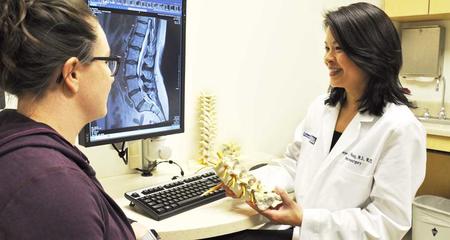Everyone experiences spasticity differently, and symptoms may change over time. We begin by carefully assessing any underlying medical conditions and current symptoms. If necessary, we may order additional tests to better understand the causes and extent of your spasticity. We will meet with you and your family to discuss your diagnosis and treatment options.
Comprehensive Assessment
During your first visit to the Spasticity Management Program, a Medical College of Wisconsin physiatrist will conduct a thorough evaluation. A physiatrist is a physician who treats disabilities from pain, injury, neurological processes or other medical issues, with the goal of optimizing and restoring overall function. He or she will take a complete medical history and perform a detailed physical and neurological exam.
The physiatrist will also review your medical records and previous diagnostic tests. You may be asked to walk or complete certain movements so the physician can see exactly how spasticity is affecting muscle motion and control. Your physiatrist will also ask about your day-to-day functioning, and will want to know what treatments, if any, have been helpful in the past. Family members are welcome to attend this evaluation because we understand that spasticity affects family relationships.
By the end of your initial evaluation, you and your family will have a better understanding of spasticity and your physician will have identified any functional impairments that limit your quality of life.
Diagnostic Tests
Sometimes, additional diagnostic tests, such as blood work or imaging studies, are ordered. Requested tests may include X-rays or an EMG.
X-Rays
X-rays can help determine if a problem with a bone is contributing to abnormal movement or positioning.
Nerve Conduction Studies and/or Electromyogram (EMG)
These tests may be used to assess nerve and muscle function. A nerve conduction study uses electrical impulses to stimulate the nerves. An EMG measures the electrical impulses generated by the muscles during movement.
Many patients with spasticity do not need diagnostic testing.
Discussing Options
When your initial evaluation has been completed, the physiatrist will meet with you and your family to discuss findings and set goals for treatment. The doctor will work with you to develop reasonable goals that improve function and an individualized treatment plan to help you meet your goals.
Virtual Visits Are Available
Safe and convenient virtual visits by video let you get the care you need via a mobile device, tablet or computer wherever you are. We'll assess your condition and develop a treatment plan right away. To schedule a virtual visit, call 414-777-7700.
More to Explore





